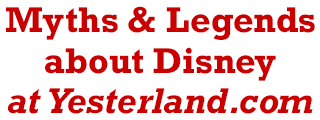
|
Unknotting the Treehouse Legend Disneyland’s Swiss Family Treehouse and Anaheim’s Founders’ Park by Chris Jepsen |
||
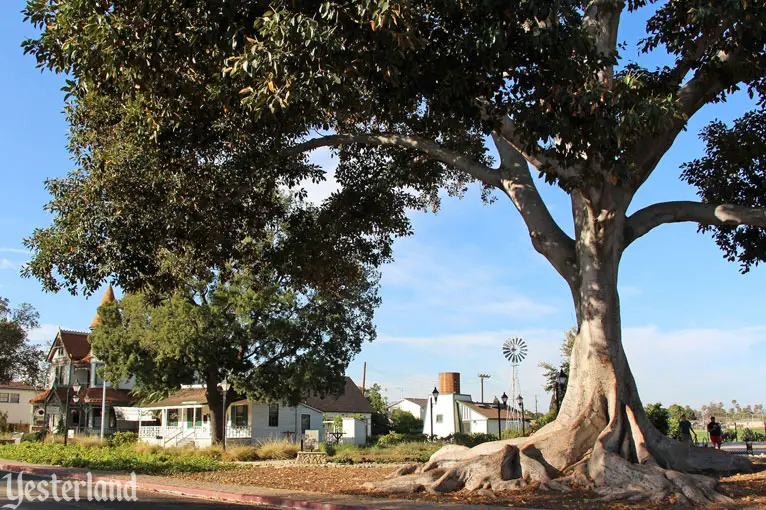
Photo by Chris Jepsen, 2014 |
|||
|
Orange County historian Chris Jepsen looked into the real story of the connection between an impressive Moreton Bay fig tree in an Anaheim city park and Disneyland’s Swiss Family Treehouse.
|
|||
|
The Claim: “Anaheim’s Moreton Bay fig tree inspired Walt Disney to build Disneyland’s Swiss Family Treehouse.” Status: False The Claim: “Anaheim’s Moreton Bay fig tree had a role in the creation of Disneyland’s Swiss Family Treehouse.” Status: True |
|||
|
|
|||
|
Unknotting the Treehouse Legend
In the jungle canopy high above Disneyland’s Adventureland, there’s a mystery to be explored: Since at least the 1980s, urban legends have circulated that a giant Moreton Bay fig tree, located at 400 N. West St., at what’s now Founders’ Park in Anaheim, served as the inspiration or model for Disneyland’s Swiss Family Treehouse. Some versions of the tale go so far as to suggest that Walt Disney personally gave the tree’s owner a lifetime pass to Disneyland as a gesture of appreciation. However, actual documentation of this widespread story has been sketchy, at best. Was there ever any truth to it? Let’s begin with the fig tree on West St., which was imported from Australia prior to 1876 by Timothy Carroll, Anaheim’s first nurseryman, and was planted by the Horstmann family. Carroll is best known as the inventor of the “Carroll Beet Dump”—a contraption which significantly cut the labor involved in transporting sugar beets from farm to factory, revolutionizing the industry. According to an article in the Aug. 5, 1926 edition of the Anaheim Gazette, there were almost no trees on the land prior to the establishment of the German vineyard colony called Anaheim: “Previous to laying out the colony, in 1858, there were no trees about Anaheim except a series of scrub oak… Some of the old-timers planted sycamore trees and later on eucalyptus trees.” Around 1876, four or five Moreton Bay Fig trees were planted in Anaheim, including the one on N. West Street. The article relates the tree’s rocky start: “A large rubber tree on the Dwyer Ranch, on N. West Street was frozen back by the severe frost which swept away the vineyard in [1876 or 1877]. Two shoots grew out the following spring, and one of these is now the huge tree on the old home place, which is one of the largest rubber trees in the city.” After that portion of the Dwyer Ranch was subdivided, the tree stood for many years in front of a modest home. This changed when the city purchased the land and razed the house during the development of Founders’ Park. In 2009 Anaheim’s City Council designated this fig tree as the city’s first Landmark Tree. |
|||
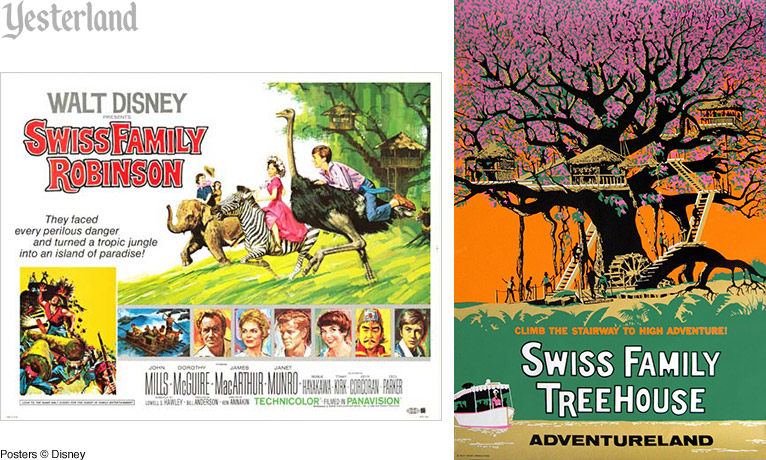
© Walt Disney Productions The movie and the attraction that it inspired |
|||
|
The Swiss Family Treehouse stands almost two miles away, along the banks of Disneyland’s Jungle Cruise. The attraction opened in 1962, two years after the 1960 release of Disney’s hit adventure movie, Swiss Family Robinson, which, in turn, was based on an 1812 novel by Johann David Wyss. The film was shot in Goldsborough, Tobago, where a treehouse set was built in an enormous Samaan tree (which is still alive today). Walt Disney was convinced that everyone—deep in their hearts—wanted their own treehouse, and that a giant treehouse like the one in his movie would be a hit with Disneyland guests. Most of Disney’s designers at WED Enterprises (now called Walt Disney Imagineering) believed the treehouse would be a flop. No one would climb all the way to the top, they thought, only to have to climb back down again. |
|||
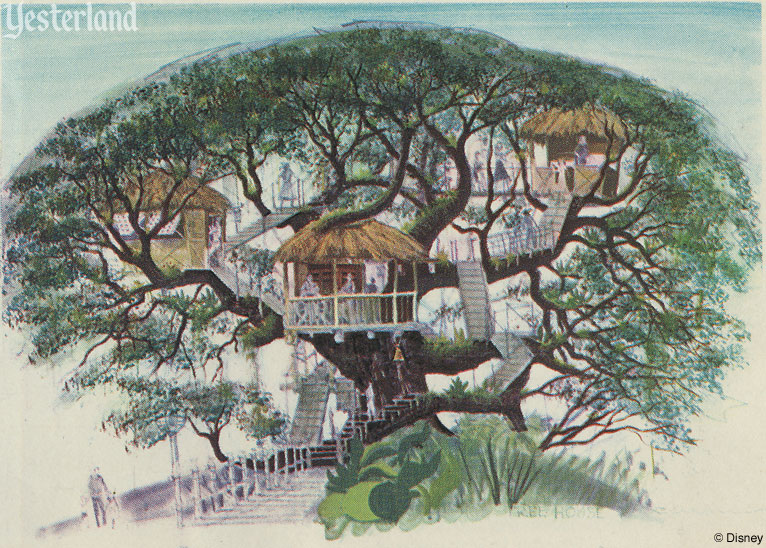
Walt Disney’s Guide to Disneyland © 1961 Walt Disney Productions Detail from “Dreaming“ in the 1961 edition of Walt Disney’s Guide to Disneyland |
|||
|
In his book The Disneyland Story: The Unofficial Guide to the Evolution of Walt Disney’s Dream, Sam Gennawey writes, “Imagineer Bill Martin began working on the walk-through attraction in January 1962. Artist Jack Ferges crafted a 4-foot model that accurately captured the majesty of the tree house from the film. The engineers used the model to draft the structural drawings. The artificial banyan tree was 70 feet tall and 80 feet wide. The 18-foot-wide tree trunk was supported by 10 concrete pilings, each 2 feet in diameter. Disguised as tree roots, the pilings were buried 42 feet down. The trunk was a hollow concrete pedestal to the height of the first bedroom. The tree was fabricated out of… concrete and… reinforced steel… The limbs of the tree… [and] the small terminal branches were made of steel tubing. Fitted into the tubes were manzanita branches covered with plastic leaves. All the steel work was covered with plastic to look just like a natural tree, including the massive root system at ground level.” It turned out Walt was right about the treehouse being a hit with the public. After the attraction’s opening, the adult climbers outnumbered the kids three to one. (On an interesting side note: The construction of the treehouse eliminated the canal that connected the waters of the Jungle Cruise to the Rivers of America.) |
|||
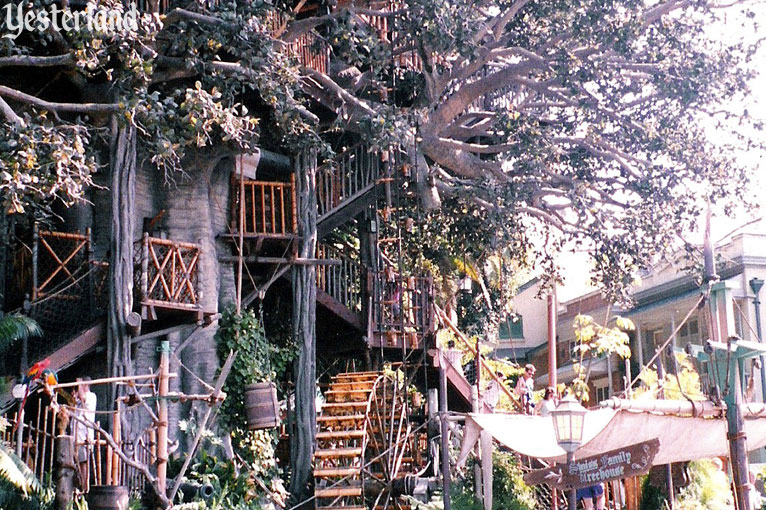
Photo by Chris Bales, 1995 Swiss Family Treehouse at Disneyland |
|||
|
But what does the real fig tree at Founders’ Park have to do with the artificial “Disneyodendron semperflorens grandis” (large, everblooming Disney tree), supporting the Swiss Family Treehouse? The City of Anaheim’s Heritage Services Manager, Jane Newell, related an anecdote from a Mother Colony House tour she gave at least five years ago to members of the Anaheim High School class of 1959 or 1960. She said that one man in the group shared that he “used to cut the grass at the house with the Moreton Bay Fig tree which was owned at that time by Katherine Moon, owner of Moon’s Gift Shop in Anaheim. One day, when he was cutting the front lawn, he saw a car pull up and a man get out with a camera. He recognized the man as Walt Disney, and overheard him asking Mrs. Moon for permission to take pictures of the tree. Of course, at the time he didn’t realize the significance of what he observed.” Also, rumors persist of undated photos of the West St. tree in Disney’s corporate archives, mixed among many other reference photos of miscellaneous trees. While we can’t currently lay hands on documented evidence of visits by Walt Disney, it’s clear that someone in the Disney organization took note of the huge fig tree as reference for the treehouse. In the early 1960s, Disneyland sent a couple employees over to N. West St. on a very specific mission. The widow of Otto Hahn—one of the employees assigned to that task—shared her husband’s story in a June 2014 interview. “My husband Otto worked at what they called the ‘Staff Shop’ at Disneyland,” she said, “They’d bring down small models of elephants or boulders or whatnot from Burbank, and the Staff Shop would build the framework and forms for the full-sized versions. They’d put the clay on there and then the sculptors would come in and do the detail work. Then Otto and the other people at the Staff Shop would pour the molds and then make the rubber or fiberglass final version of the sculptures that would appear in the various attractions. “By the time the Disney people asked Otto to visit this big rubber tree in Anaheim, construction on the Swiss Family Robinson Treehouse was mostly done. The lady who lived in the house behind the tree came out to see what was going on, and she was very pleasant. The tree had recently been trimmed and she let him take large branches with him back to the shop to make molds of the knots. He didn’t do the work on site. And he only made molds of the knots—not the roots. They then used the molds to make the large knots on the Swiss Family Robinson tree out of fiberglass. He also put a lot of the flowers and leaves on the tree. And he worked on many of the other attractions, like the Submarine Ride, making fake rocks; the Jungle Cruise; Small World, with Cleopatra; and others.” |
|||
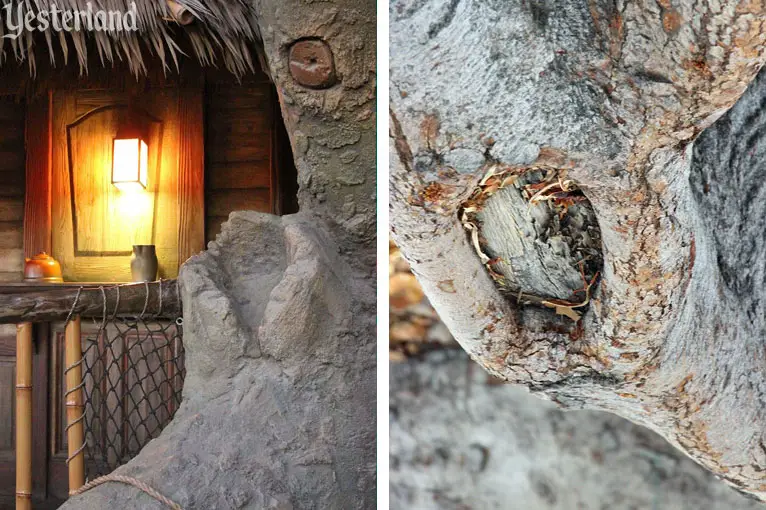
Photos by Chris Jepsen, 2014 Knots: Disneyland (left), Founders’ Park (right) |
|||
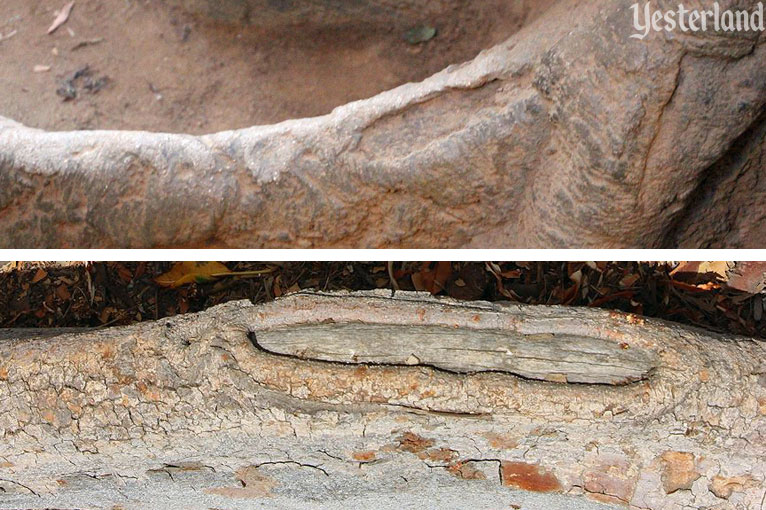
Photos by Chris Jepsen, 2014
More knots: Disneyland (top), Founders’ Park (bottom) |
|||
|
By the 1980s, the molds made from the tree’s knots had been spun into a popular urban legend in which the tree was central to the creation of the Swiss Family Treehouse. Disney fanatics from around the world stopped at the tree on West Street to see a “little known” piece of Disneyland history. Gross exaggerations can be good for tourism. In 1999, a large “old decayed tree” was added next to the Swiss Family Treehouse, with a suspension bridge added between the two, as part of the attraction’s re-theming as Tarzan’s Treehouse. The Robinsons are long gone, and at least some of the air has been let out of the old urban legend. But the beautiful Moreton Bay fig tree imported by Tim Carroll is still alive and well. |
|||
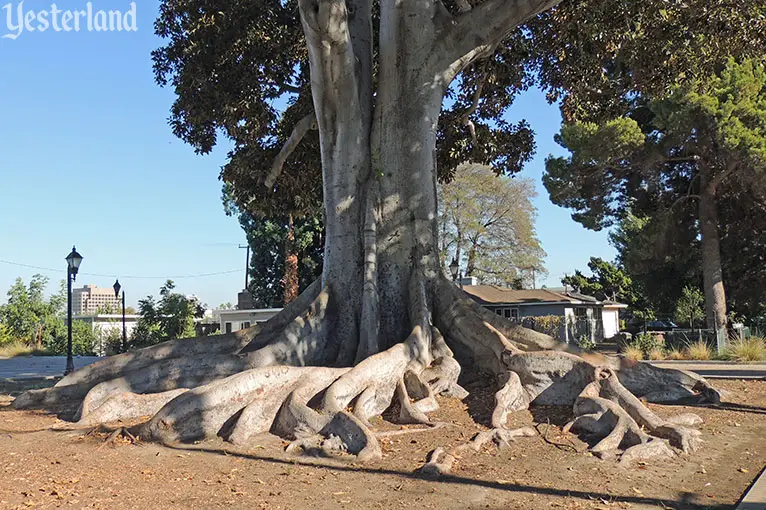
Photos by Werner Weiss, 2013 Base of the Moreton Bay fig tree |
|||
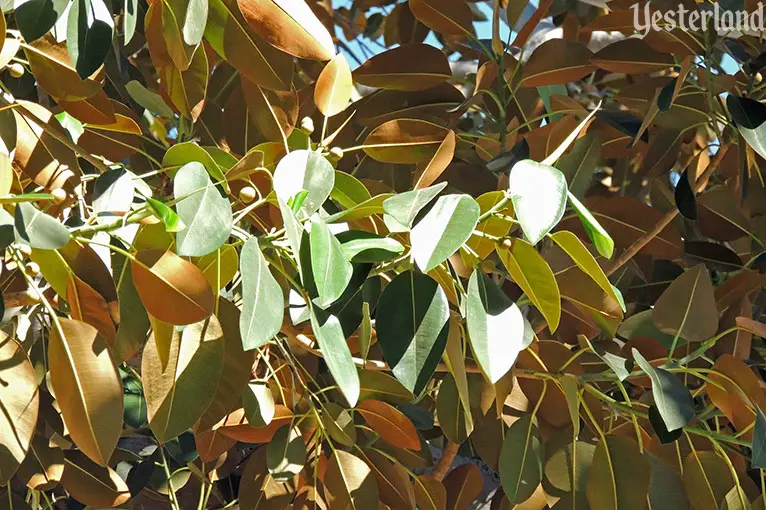
Photo by Werner Weiss, 2013 Leaves of the Moreton Bay fig tree |
|||
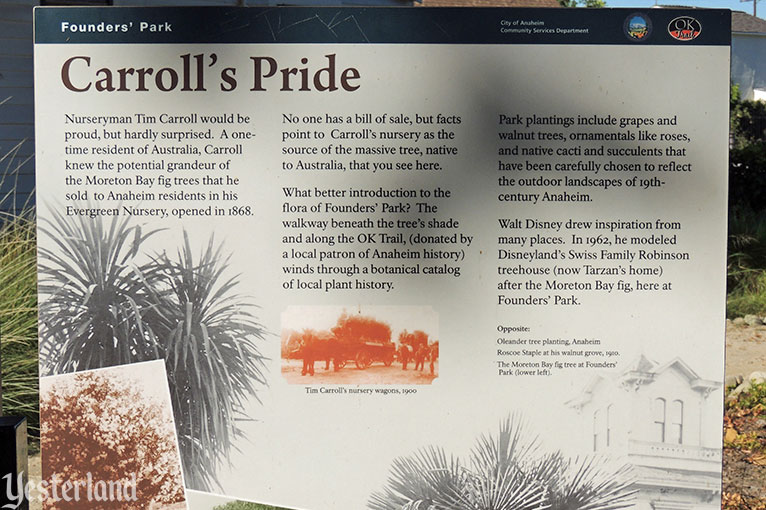
Photo by Werner Weiss, 2013 Sign in Founders’ Park |
|||
|
About Chris Jepsen Chris Jepsen is a local historian in Orange County, California. He is also president of the Orange County Historical Society and Assistant Archivist at the Orange County Archives. Chris thanks Werner Weiss for launching this “tree project,” as well as Jane Newell, Joy Hahn, and Don Dobmeier for their help. |
|||
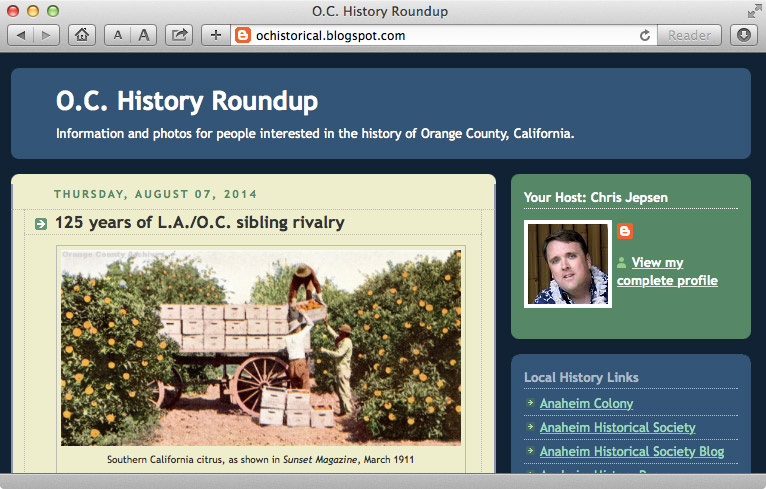
screen capture O.C. History Roundup by Chris Jepsen [opens new window] |
|||
|
About Founders’ Park To learn more about Founders’ Park, including historical home tours, visit the Anaheim Public Library’s official Founders’ Park information page [opens new window]. |
|||
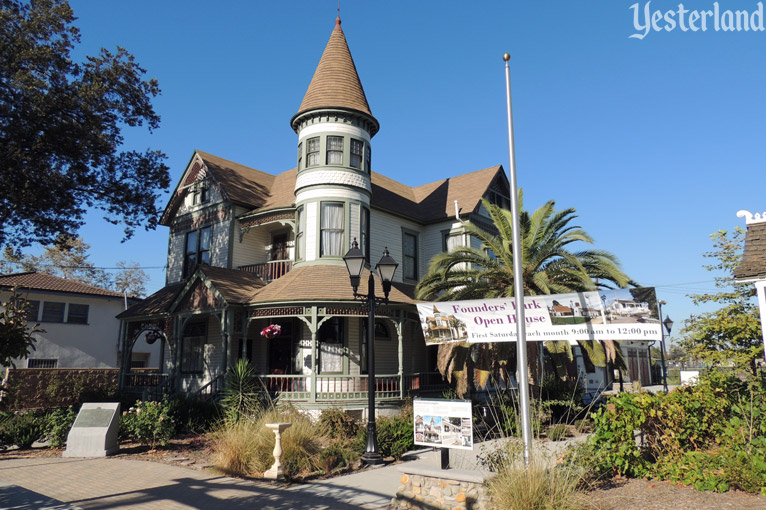
Photo by Werner Weiss, 2013 Woelke-Stoffle House at Founders’ Park |
|||
|
|
Click here to post comments at MiceChat about this article.
© 2015-2018 Werner Weiss — Disclaimers, Copyright, and Trademarks Updated May 19, 2018. Thank you to John Delmont for introducing Werner Weiss to the Moreton Bag fig tree in Anaheim. |
||